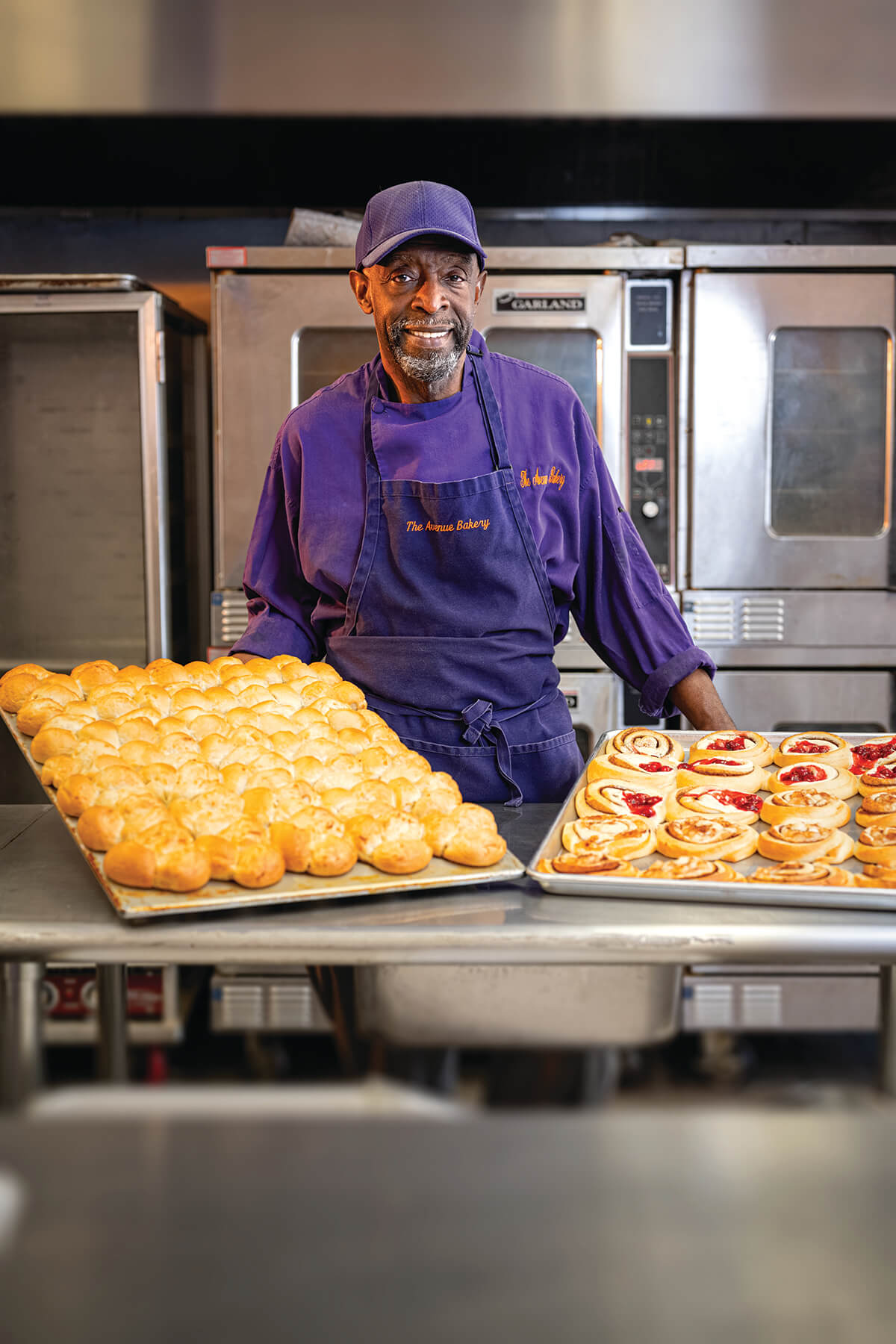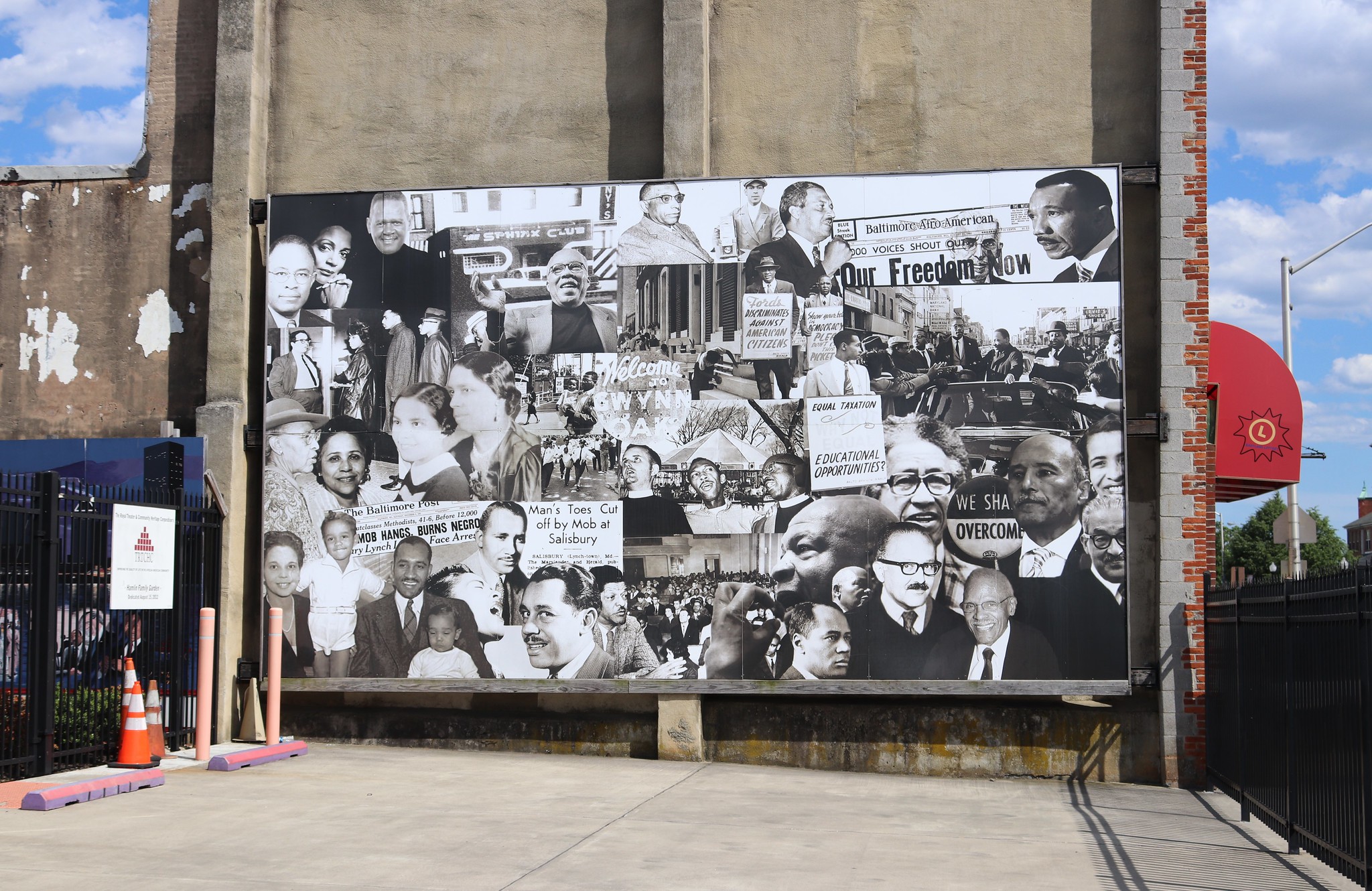News & Community
Roll of Honor
Jim Hamlin dreams of revitalizing West Baltimore with the help of his 10-year-old The Avenue Bakery.

They call him “Carbo-Man,” a nickname that James “Jim” Hamlin proudly accepts. “I’m a carbohydrates guy,” he explains. “No, I don’t look like it because I’m 158 pounds and my BMI is exactly where it’s supposed to be, but I consume bread more than anything else.”
Hamlin consumes so much bread, in fact, that he decided to learn how to make some himself. He started by trying to replicate the golden dinner rolls his mother used to bake when he was a child. Spending hours in the kitchen of his neighborhood home without a recipe, he tinkered with ingredients and measurements to get the perfect batch. When he did, he knew he was onto something.
“He had his mother taste it,” says Brenda Hamlin, Jim’s wife of more than 50 years, who works with him at the bakery. “And I remember she looked at him and said, ‘These are good. These are better than mine.’”
The rolls quickly caught on. Hamlin, who grew up in a family of 10, soon began baking rolls on holidays and for gatherings. Rolls for his siblings, family friends, and extended family. Rolls for neighbors and friends of friends.
“It was getting out of hand,” says Brenda. “Especially after he retired, I would come home from work and I couldn’t find my dining room table. I couldn’t find my kitchen counter. I couldn’t find anything because there was bread all over the place. I said, ‘You need to find a place to do this, because I’m tired of not being able to find my house.’”
On one hand, you could argue that opening The Avenue Bakery was a natural next step after being booted from the kitchen. But for Hamlin, a retired UPS Community Relations Manager, the story is far greater than that. Celebrating its 10th anniversary this August, The Avenue Bakery is the manifestation of his mission to reclaim and restore the cultural legacy and history of Pennsylvania Avenue and greater West Baltimore.
“The bakery was not a plan. It was not a goal. The bakery is a means to an end,” explains the 72-year-old Hamlin. The end, propagated by his nonprofit The Royal Theater & Community Heritage Corporation, aims to revitalize the 21217 zip code portion of Pennsylvania Avenue and the area around it by rebuilding the Royal Theatre.
“2-1-2-1-7 on Pennsylvania Avenue and the surrounding community were the epicenters of the African-American [life] in Baltimore,” Hamlin says. “This is a community where Cab Calloway walked. This is where Billie Holiday landed. This is where Thurgood Marshall grew up. This is where every entertainer that you can think of has walked up and down The Avenue and entertained at The Royal Theatre.”
The Royal Theatre opened in 1921 and served as a linchpin to a larger cultural movement. The “Chitlin’ Circuit” was a series of venues which included The Howard Theatre in Washington, D.C., The Fox Theatre in Detroit, The Apollo in New York City, and, of course, The Royal Theatre in Baltimore. The venues housed some of the world’s greatest musical acts and entertainers—something the Hamlins remember fondly.
“I’d get up early and get all my chores done to wait until I could get to the show,” Brenda recalls. “I mean, you would see The Supremes, The Marvelettes, The Temptations, The Contours, Sam Cooke. I saw Dionne Warwick and Patti Labelle and the Bluebelles. I even remember seeing Stevie Wonder when he was 13 years old playing his harmonica and singing at The Royal.”
“THE BAKERY WAS NOT A PLAN,” SAYS HAMLIN. “THE BAKERY IS A MEANS TO AN END.”
For Hamlin, who grew up in West Baltimore, where Pennsylvania Avenue was the business and economic center of the community, memories of his early childhood are filled with images of a vibrant city. He recounts in detail the paper boys who rode down the block, the corner stores with doors wide open welcoming visitors and tourists, the shoe repair shop and shoe shiners down the way, and the hardware stores that lined the street. He explains how, on any given day, you could bump into James Brown looking to find somewhere to eat before a show. The Avenue was filled with possibilities, and more importantly for Hamlin, the Avenue gave way to job opportunities.
“My first job was at Archie Laden’s grocery store, at the age of 13,” he says. “I worked there every day after school and all day on Saturdays. I was able to buy my blue-tipped tennis [shoes] and my khaki pants for school. Today in our community, you can’t do that.”
The Royal Theatre was torn down in 1971. The loss was a blow to the community and exposed the realities of a rapidly changing city. Gone were the job opportunities, the newspaper boys, and the grocery stores. Gone was the glitz and glamour of taking in a Saturday matinee show. Gone were the marquees of the now-shuttered theaters. There were many reasons for this gradual degradation—redlining chief among them.
“We have been fighting a drug and crime war since the riots of 1968, and it’s only gotten worse,” says Hamlin. “I don’t know if our politicians and community leaders realize what the disease is. The disease is an economic disparity in Baltimore City.”
As he got older, Hamlin became more and more despairing about the state of his old neighborhood. He decided to do something about it.
“One person I know was telling me, ‘You know, James, if you want to change Pennsylvania Avenue, you have to put something on the Avenue that you can’t get anyplace else,’” he says.
So, on August 15, 2011, the retired (or so he thought) Hamlin returned to the workforce once more and opened The Avenue Bakery—Home of Poppay’s Rolls. It’s only fitting that his signature dish bears the nickname given to him by his granddaughter. When customers walk into The Avenue Bakery, they are greeted by an assortment of images and sounds. Sam Cooke plays on a speaker in the back room. The walls are lined with portraits of local leaders and Baltimore entertainers, and a map of the Pennsylvania Avenue Heritage Trail demarcates the location of famous landmarks throughout the city. A large sign on the wall reads: “Welcome to The Avenue Bakery. Our lobby is dedicated to the history of our community.”
The business plan is simple—provide world class goods and services to the community, prove that businesses can thrive on Pennsylvania Avenue, and educate customers on the history and legacy of greater West Baltimore.
“What we have created,” says Hamlin, “is an eye-opening oasis for people who have experienced The Avenue in its heyday, [people] who understand the culture or who have been told the stories by their parents and grandparents.” The bakery’s extensive menu is an homage to African-American culinary classics—peach cobbler, apple cobbler, apple pie, sweet potato pie, and bean pies. “People come for that,” Hamlin explains, “but when they come here, they’re shocked because of all the history and all the legacy that’s there.”
THE BAKERY’S EXTENSIVE MENU IS AN HOMAGE TO AFRICAN-AMERICAN CULINARY CLASSICS.
The legacy is perhaps best depicted by the 16-foot-tall collage-like mural on the wall right outside the bakery. There, customers will find an assortment of images including a photo of Martin Luther King Jr. in a motorcade on Pennsylvania Avenue taken in 1964, the front covers of multiple editions of Baltimore’s Afro-American newspaper, and images from the Gwynn Oak Amusement Park protests in 1963. The mural has become a landmark in its own right, serving as a backdrop for demonstrators during the 2015 Uprising following the death of Freddie Gray and last summer’s protests over the murder of George Floyd.
“I brought a few of my students here,” says Tenyo Pearl, an educator at Coppin State. “[James] has taught us the importance of capturing our history—Baltimore history—because we love our city.”

In this way, the bakery has attracted customers from across the nation. Students come to the bakery on school trips, family reunions congregate at the bakery for breakfast, the church crowd comes on Sundays after service, and curious tourists walk in to check the place out.
“We have four signing books over the 10-year period,” says Hamlin. “You can go through each book and you can find people from all over the country who have visited the bakery. Imagine—if you can do all this with a little bakery on Pennsylvania Avenue—imagine what could happen if we [rebuilt] the theater.”
It’s clear that Hamlin has a distinct vision for Pennsylvania Avenue. Images of a growing metropolis preoccupy his mind. He will be the first to tell you that the third largest industry in Baltimore is tourism. The theater’s development has the potential to provide thousands of job opportunities for Baltimore residents. By drawing crowds of visitors from all over the world, The Royal Theatre could sanctify Baltimore’s place as a cultural entertainment capital.
Plans are already underway to continue to develop Pennsylvania Avenue as an arts and entertainment district, a designation it officially earned in 2019 when it was anointed The Pennsylvania Avenue Black Arts & Entertainment District. The push, led by Lady Brion, Founder and Executive Director of the Black Arts District, gives ways to a new generation of Baltimoreans looking to both preserve the corridor’s history and forge a new future.
“If I were to imagine the best version of the Black Arts District,” Brion says, “it’s a space where everyone has something for them. Where we are doing the work of preserving parts of that childhood the elders remember, but where we’re also making space for the upcoming and burgeoning artist to find a place to grow and professionalize their practice.”
Brion speaks fondly of Hamlin and the role The Avenue Bakery has played in advocating for the district’s designation. “The Avenue Bakery is a staple in West Baltimore. Poppay’s Rolls is a staple in Baltimore, and I’m so proud to have someone like Mr. Hamlin as a stakeholder [in our movement]. Someone who consistently works not just to build for the bakery but beyond the bakery to preserve the history of West Baltimore. We’re thankful to have him as a partner and a co-conspirator.”
But not everyone believes in Hamlin’s vision. Having gained support from political powerhouses such as former Governor Martin O’Malley and former Baltimore Mayor Stephanie Rawlings-Blake during their respective administrations, the development projects for the Royal Theater and Community Heritage Center have failed to convince current political leaders and the Upton Planning Committee that oversees the development site.
“[People] keep telling me that nobody is going to come to Pennsylvania Avenue,” says Hamlin. “But I’ve got books in there that will tell you that people are going to come back!”
There is a growing frustration in Hamlin’s voice as he reflects on the trials and tribulations of the past 10 years. In many ways, the mission—the rebuilding of The Royal Theatre—should have been realized by now.
“Maybe I haven’t done a good job of opening their eyes and getting them to see reality,” he says. The work has understandably taken a toll on Hamlin and his family. “I was supposed to be here until we could hire somebody else to replace me, right dear?” says Brenda, laughing. Hamlin nods with a smile, “We’re working on that.”
Contemplating whether or not to transfer the bakery and the mission to his kids and grandkids, Hamlin does not seem ready just yet to let the dream go. For Hamlin, even amidst struggle and the confines of time, the more important things are always worth fighting for.
“That’s life, we haven’t given up yet,” he says, as he takes one long look at the images on the storefront mural before heading back inside to finish the day.